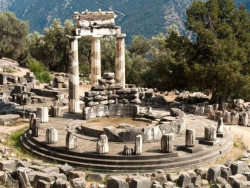Archaeological Site of Delphi

Archaeological Site of Delphi
Slowly over the next five centuries the sanctuary grew in size and importance. During the 8th c. B.C. Delphi became internationally known for the Oracular powers of Pythia - the priestess who sat on a tripod, inhaled ethylene gasses, and muttered incomprehensible words that foretold the future.
The ancient people of the Mediterranean had such faith in Pythia's view of the future that no major decision was made without consulting the Oracle of Delphi first. Greek and foreign dignitaries, heads of state, and common folk made the pilgrimage to the Delphi sanctuary, and paid great sums for Pythia's oracles. Since the sanctuary only served the public a few days over nine months out of the year, great sums were paid by the more affluent ones in order to bypass the long line of pilgrims.
Such was the importance of the Oracle at Delphi that the ancients believed it to be the center ("Omphalos") of the world. The oracle advised the great Persian Kings of the time, and when the Persians were poised to sack Athens, Themistocles turned the advice of the Oracle to a winning strategy that led to the Greeks' victory in the naval battle of Salamina. The Oracle had simply advised that "wooden walls" would aid to victory, and Themistocles interpreted walls to mean the wooden ships of the Athenian fleet.
From the 7th Century B.C. and at least until the 4th Century, the sanctuary of Delphi was part of the Amphictyonia. The Amphictyonia alliance protected the site from many invaders. Despite some building revivals by the Romans, the Oracle of Delphi lost its influence over the next few centuries, and its spiritual fire was gradually extinguished as Apollo's worship was replaced by a new religion imported from the East: Christianity.
These days, Delphi is a Site of World Heritage, according to UNESCO, where the visitor may admire many monuments; among them are the Temple of Apollo, the Tholos, the Athenian Treasury and the Ancient Theater of Delphi. The many findings of the archaeological site – one of them is the bronze statue Charioteer of Delphi also known as Heniokhos – are exhibited in the Archaeological Museum of Delphi.









